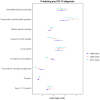Characteristics of children with a psychiatric disorder in 1999, 2004 and 2017: an analysis of the national child mental health surveys of England
- PMID: 39044702
- PMCID: PMC11754707
- DOI: 10.1111/jcpp.14040
Characteristics of children with a psychiatric disorder in 1999, 2004 and 2017: an analysis of the national child mental health surveys of England
Abstract
Background: While research has described the profile of children with poor mental health, little is known about whether this profile and their needs have changed over time. Our aim was to investigate whether levels of difficulties and functional impact faced by children with a psychiatric disorder have changed over time, and whether sociodemographic and family correlates have changed.
Methods: Samples were three national probability surveys undertaken in England in 1999, 2004 and 2017 including children aged 5-15 years. Psychiatric disorders were assessed using the Development and Well-Being Assessment (DAWBA), a standardised multi-informant diagnostic tool based on the tenth International Classification of Diseases (ICD-10). The impact and difficulties of having a disorder (emotional, behavioural or hyperkinetic) were compared over time using total difficulty and impact scores from the Strengths and Difficulties Questionnaire (SDQ). Analyses explored the impact of having any disorder, as well as for each disorder separately. Regression analyses compared associations between disorders and sociodemographic factors over time.
Results: Parent- and adolescent-reported total SDQ difficulty and impact scores increased between 1999 and 2017 for children and adolescents with disorders. No differences were noted when using teacher ratings. No differences in total SDQ difficulty score were found for children without a disorder. Comparison of sociodemographic correlates across the surveys over time revealed that ethnic minority status, living in rented accommodation and being in the lowest income quintile had a weaker association with disorder in 2017 compared to 1999.
Conclusions: Our study reveals a concerning trend; children with a disorder in 2017 experienced more severe difficulties and greater impact on functioning at school, home and in their daily lives, compared to children with a disorder in earlier decades. Research is needed to identify and understand factors that may explain the changing nature and level of need among children with a disorder.
Keywords: Child mental health; functioning; psychiatric disorder; secular change; time trends.
© 2024 The Author(s). Journal of Child Psychology and Psychiatry published by John Wiley & Sons Ltd on behalf of Association for Child and Adolescent Mental Health.
Figures



References
-
- Ahmad, G. , McManus, S. , Cooper, C. , Hatch, S. , & Das‐Munshi, J. (2022). Prevalence of common mental disorders and treatment receipt for people from ethnic minority backgrounds in England: Repeated cross‐sectional surveys of the general population in 2007 and 2014. The British Journal of Psychiatry, 221, 520–527. - PMC - PubMed
-
- Armitage, J.M. , Kwong, A.S.F. , Tseliou, F. , Sellers, R. , Blakey, R. , Anthony, R. , … & Collishaw, S. (2023). Cross‐cohort change in parent‐reported emotional problem trajectories across childhood and adolescence in the UK. Lancet Psychiatry, 10, 509–517. - PubMed
MeSH terms
Grants and funding
LinkOut - more resources
Full Text Sources
Medical

